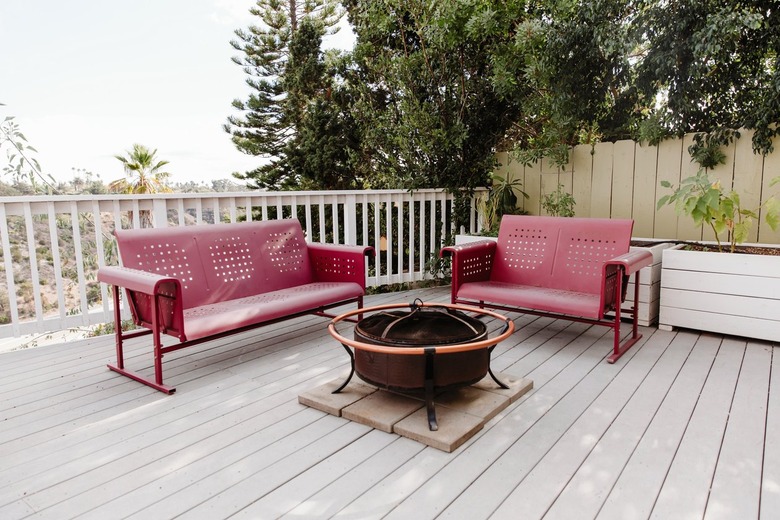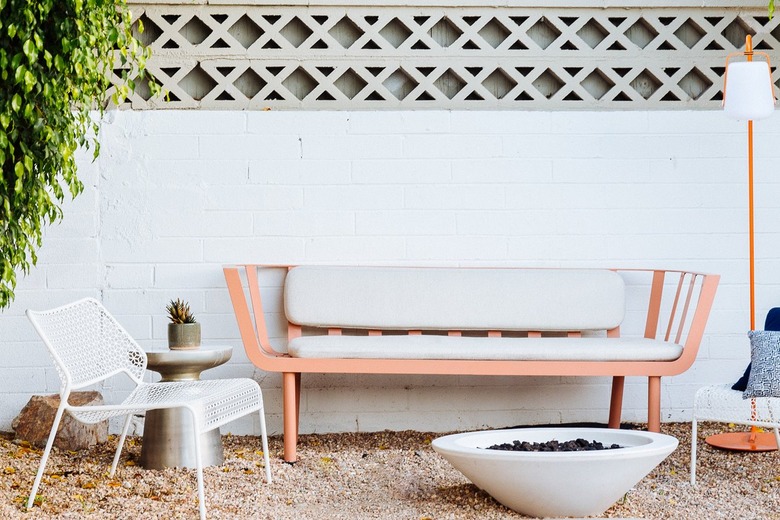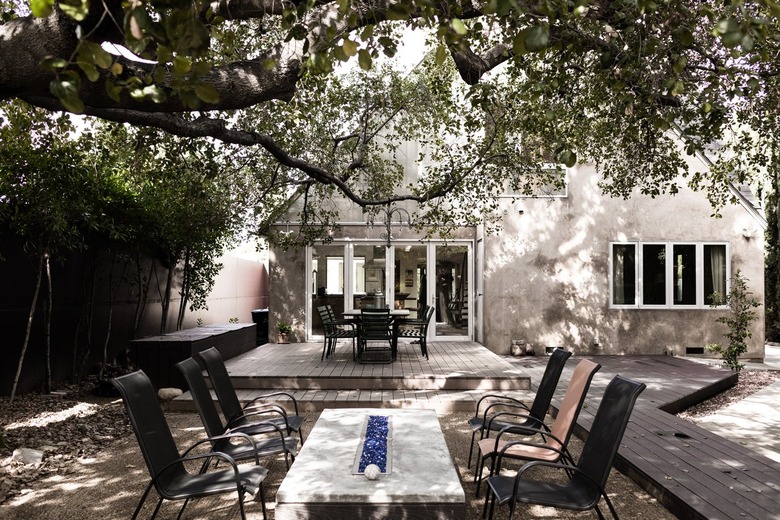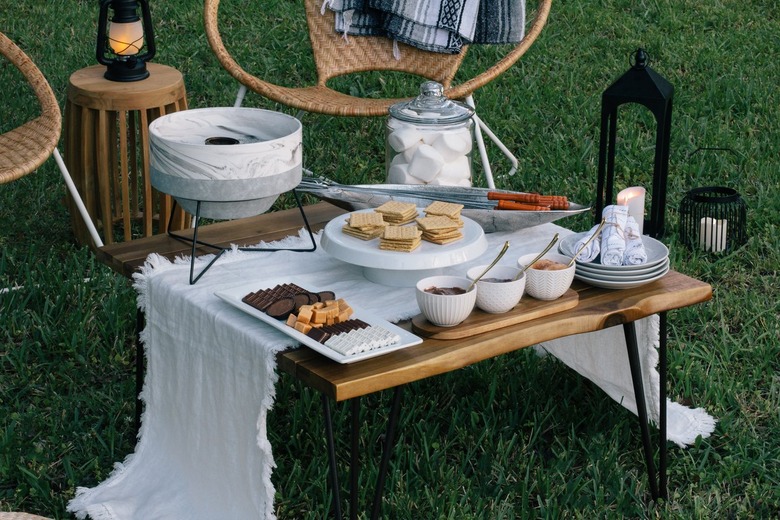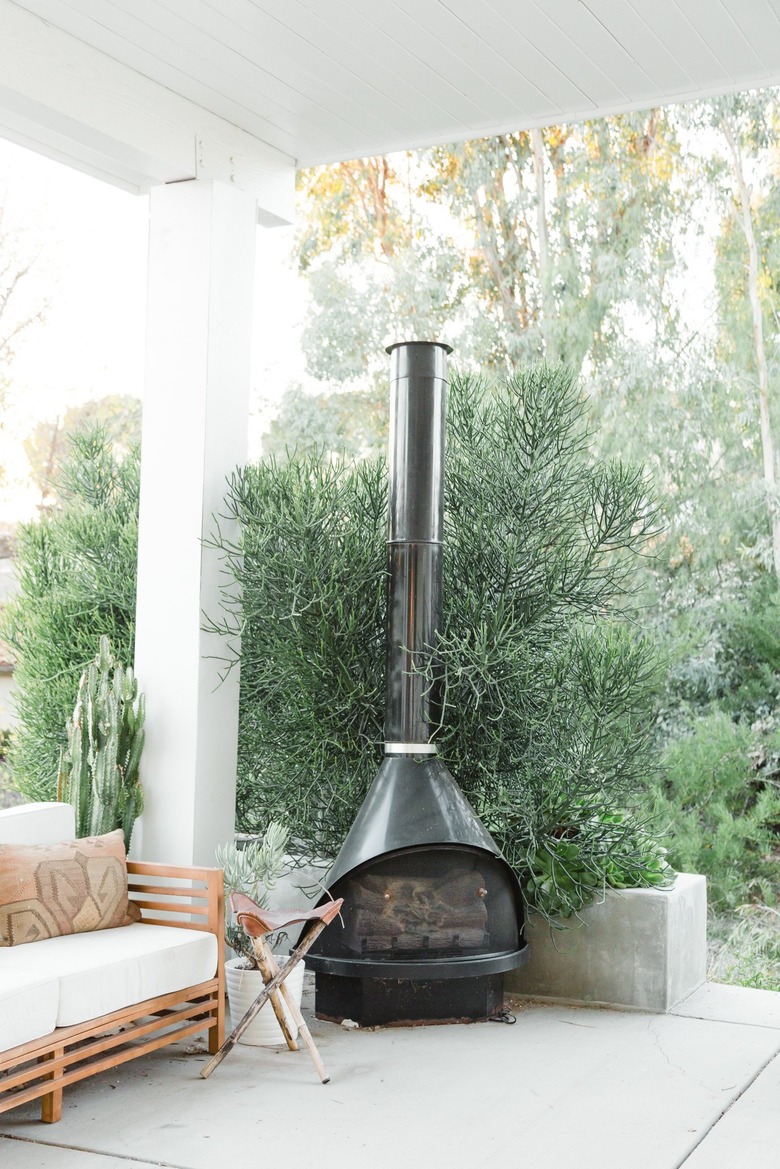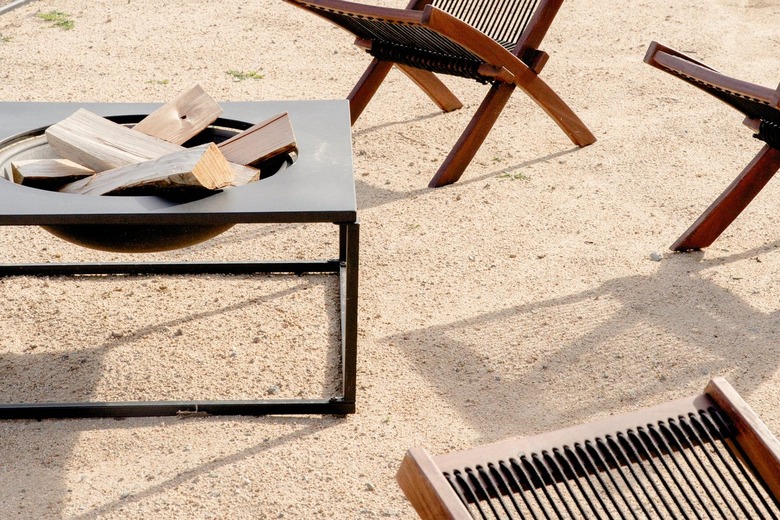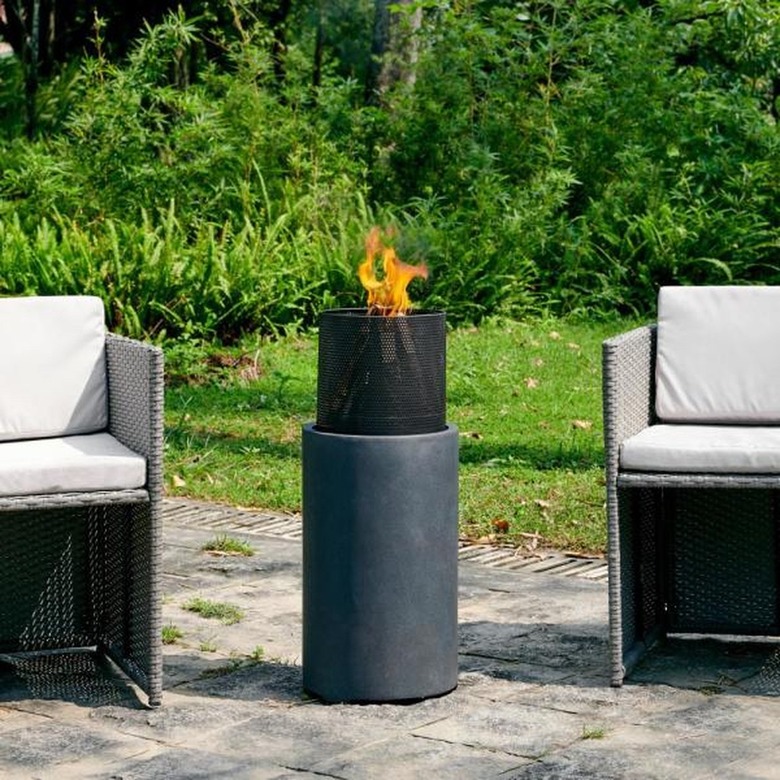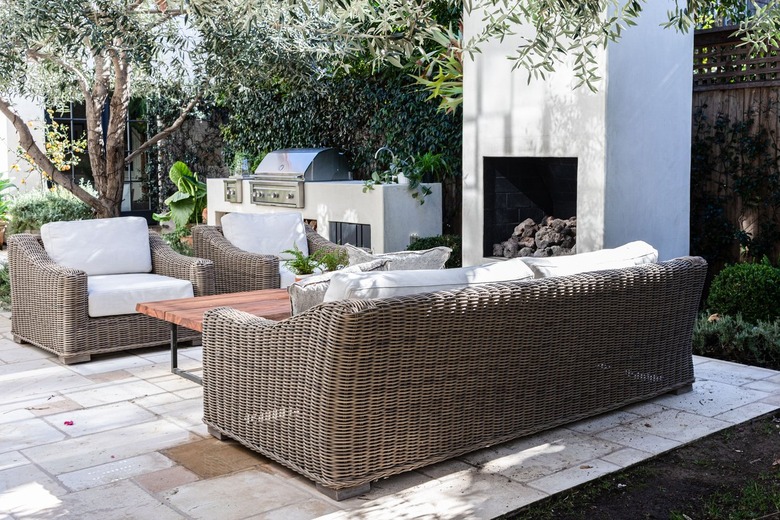12 Types Of Fire Pits For Your Outdoor Space And How To Use Them
It's not difficult to see the benefits of sprucing up your outdoor space with a fire pit. For one, these eye-catching accessories serve as a year-round entertainment source, they sufficiently illuminate outdoor living spaces after dark, they offer warmth if you want to hang outside when it's chilly, and they bring an inviting, cozy ambiance that simply doesn't compare to an electric light source. Did we mention you can cook s'mores on a fire pit? Impressing your guests with a snuggly setup and toasty treats sounds like a dream situation to us.
But before you start planning a backyard shindig to show off your new fire pit, there are a few factors to take into consideration. In order to make the best decision, consider where you'd like to put your fire pit. Keep in mind that it needs to be placed a safe distance from your home (and any combustible materials), in an open area — at least 15 feet away should do the trick. Also, the size of your fire pit depends on how much space you have and how prominent of a focal point you want it to be. Then, there's purpose. Are you installing a backyard fire pit strictly as a warm central gathering area or do you plan to use it to cook food? These details will help you decide which type — they are generally grouped by fuel type — and style would work best for you.
4 Types of Fire Pits
4 Types of Fire Pits
1. Wood Fire Pit
Wood-burning fire pits work very much like campfires and are extremely popular for backyard setups. They are the easiest to install, plus the enclosure for wood-burning fire pits can be made of any material that won't burn, like metal or stone, and will include a structure to contain the logs. This option can also double as a grill for those who enjoy cooking outdoors. The fire size can range from small to large, depending on the user's preference — simply add more logs for a larger fire. Cut firewood is fairly inexpensive to buy, and you just can't beat the authentic and cozy crackling that occurs when it burns.
However, some locations prohibit or restrict wood fires, so take that into consideration before you run out to purchase one. Another con of wood-burning pits is that extinguishing fires isn't instant, unlike with its gas counterpart, which could create a safety issue. Even if you use water or sand to put out the fire, you'll need to double-check that it's completely extinguished before leaving the pit unattended. Also, cleaning a wood-burning fire pit can be quite tedious (lots of ash-scooping), and regular use could result in discoloration of the structure.
Experts recommend placing all fire pits at least 10 to 25 feet away from the house, trees, or any other combustible materials. Open, uncovered spaces are best, especially since wood-burning pits tend to produce plenty of heat, smoke, and sparks. If you fancy placing your fire pit on a patio deck, you should check your local fire codes first, and at a minimum, you'll need to add a barrier between the deck and the pit to prevent overheating.
2. Propane
A fire pit powered by liquid propane is more portable than natural gas since you can buy propane in refillable tanks. It also burns clean and bright and gives off considerable heat. This particular type of fire pit is ideal for use under a gazebo, pergola, or any other outdoor structure. Propane fire pits are most commonly constructed using glass, faux wood, copper bowls, and rock pebbles. Certain types of propane fire pits can also be fitted with wheels for mobility, plus, they can be used for cooking. The downside to propane fire pits is the hefty fuel cost. The extra components that are required to safely construct this type of pit will also add to the overall price.
3. Gel Fuel
Gel fuel fire pits are yet another option that uses clean-burning fuel. Gel fuel is typically made of isopropyl alcohol, which doesn't smoke or create soot when burned, so no venting of the fire pit is required. Additionally, gel fuel fire pits don't require electricity, gas connections, or chimneys in order to operate properly. Gel fuel is commonly sold in 13-ounce cans that will burn for several hours. To use a can of gel fuel, you just pry open the lid and light the fuel, just like with a Sterno can. This is safe to use inside the house as well if you wanted to move your tabletop fire indoors for a bit of warmth. One drawback of gel fuel pits is that they don't provide as much heat as the other types.
4. Natural Gas
For faster, easier fires, you might consider a gas fire pit — natural gas or liquid propane — that only requires one flick of an igniter switch to get started. In addition, gas is cleaner and safer than wood and doesn't inundate guests with smoke. (The "smoke follows beauty" joke gets old fast.) However, installation is more difficult for natural gas units since they have to be hooked up to the home gas line. But that means an unending supply of fuel for your outdoor fires, and gas opens up the door to options like lava rock, fire glass, or ceramic log sets. Keep in mind that natural gas fire pits should be installed at least 10 feet away from any combustible structure. Ideal locations include wood decks and concrete patios.
8 Styles of Fire Pits
1. Classic Masonry Fire Pits
Anyone considering an outdoor fire pit shouldn't hesitate to take a look at the classic, traditional round enclosures constructed of brick, block, or stone. These provide something very close to the campfires of your childhood, although they may offer a more sophisticated look (and a comparably higher price tag). These are permanent structures built over a compacted gravel base or even a concrete slab.
Classic fire pits featuring 360-degree flames usually burn either wood or natural gas and are great for creating a warm atmosphere in the backyard, entertaining a group, and fireside cooking. They typically require very little maintenance and are suitable for year-round use. If these are the most important items on your outdoor fire pit wish list, then a classic pit might be the best way to go.
2. Prefabricated Fire Pits and Fire Bowls
A prefab fire pit is a manufactured, portable version of a classic fire pit and is designed primarily for ambiance, although some can be good for cooking, too. Most options are made for burning wood or propane, and they come in a range of shapes including round bowls, squares, and columns, to name a few. The term "fire bowl" usually refers to a sleek, bowl-shaped unit made of metal or cast concrete, and a "fire column" is a tall, upright design.
Portable fire pits come in many different styles and sizes, so you should select one that goes well with the rest of your outdoor decor. And while portability is the biggest draw to prefab fire pits, it's not the only advantage that they offer. Even in an area with strict rules against outdoor fireplaces or fire pits, portable, self-contained units may not be regulated. On average, they can cost anywhere between $300 and $1,400.
3. Gas Fire Tables
Classic outdoor fire pits and bowls are situated on the ground like campfires, but there are other styles that work better in some situations. Gas fire tables (using natural gas or propane) are the perfect combination of a table and a fireplace. The fire pit is located in the center of the tabletop and powered by gas. They come in a large selection of styles, shapes, and sizes.
What size? Well, what size would work best for you? Generally, they are available in the following heights just like indoor tables — so 23 inches (coffee table), 29 inches (dining table), and 35 inches (bar table). And, yes, these tables are completely functional to use as actual tables.
Gas fire tables are a sleek and contemporary option that pull double-duty as a piece of furniture as well as a sleek focal point that will create a warm and cozy atmosphere in your backyard. This option can also be found with an electric fire rather than a gas one, but the gas fire will take more of the chill off the evening air. On the low end, you can nab a gas fire table for around $250; costlier alternatives can run as high as $2,500.
4. Tabletop Fire Pits or Bowls
Don't confuse fire tables with tabletop fire pits or bowls. Both reference tables and include fire, but "tabletop" here means small and conveniently portable — in other words, perfect for small backyards. These are small fire features — often 24 inches across or less — that can be placed on an outdoor shelf, a picnic table, or any other flat surface. You can position it on a stable base whenever you are in the garden to get a warm, comfortable glow. Don't expect to thaw out frozen fingers, though. These are not the best for radiating heat.
Tabletop fire pits are fueled with gel fuel, allowing both indoor and outdoor use, although you should always read the instructions on your particular product to be sure. Experts recommend defining the purpose of your fire pit before you select a fuel type. For instance, a pit that functions strictly as a centerpiece (as opposed to cooking) should not be paired with propane or natural gas. Just because they fall into the tabletop category doesn't mean you have to put them on a table. They will work just fine on the ground or on a concrete or stone surface.
5. Chimineas
This front-loading fire pit or oven features a smoke vent or vertical chimney. And because chimineas are enclosed and draw fire and smoke into the air, they are generally deemed safer than pits with open flames. Both decorative and portable in nature, chimineas can be used for outdoor cooking, so they're perfect for gatherings. They also give off enough warmth to be used during cooler months; however, since it is only open on one side, the heat output is strongest in the front.
Chimineas are not weatherproof, so if you want to ensure their durability and maintain the appearance of your fire pit, you'll need to protect them during the wet and cold seasons by covering them with moisture-proof materials. And be sure to keep the lid on when it's raining, too. Fuel options include coal and charcoal, wood, and fire briquettes, and experts suggest lining the base of the pit with sand to provide protection.
While they are available in clay, iron, copper, and cast aluminum, steel is the most highly recommended material for a chiminea. For a clay chiminea, expect to spend between $50 to $200; meanwhile, the sturdier metal options run between $100 and $500.
6. Camping Fire Pits
A camping fire pit is essentially a small unit that can travel with you. They are usually made of stainless steel, many of which use wood, but some run off of propane. Propane is easier to start and burns cleaner without ash, but you may miss the smell and crackle of a wood fire.
If you are looking for a camping fire ring, select something sturdy and light. Keep in mind that you may be able to use a propane-burning fire pit even in outdoor spaces that don't allow campfires. Overall, camping fire pits are easy to use, they have an on-off switch that makes them a far lower fire risk, and they can be portable. These qualities make them ideal for year-round use — but only outdoors, as they are not recommended for use in enclosed areas. Prices are wide-ranging, but you can find a well-rated fire pit for as low as $200.
7. Fire Columns
Generally powered by propane or natural gas, fire columns (like this one from The Home Depot) are suitable for year-round use. They deliver a sophisticated, chic aesthetic to any space they occupy. And due to their slim, cylindrical design, fire columns take up significantly less room than their larger counterparts, so they're ideal accessories for small patios or backyards. Equipped with a push-ignite button, wood or stone typically comprise the fire column's exterior, while metal is the standard interior material.
They'll absolutely increase the elegance factor of your outdoor living space, but if you're expecting to whip up a quick meal, then the fire column won't suffice. They're strictly utilized to add style, an ambient glow, and warmth to both indoor and outdoor spaces. On average, they measure 30 inches in height, although some are less than a foot tall. For the cost-conscious shopper, fire columns are pretty affordable, starting as low as $26.
8. Outdoor Fireplaces
If you intend to spend time outdoors during the fall and winter seasons without freezing, an outdoor fireplace is the best option for you due to its high heat output. It's similar to an indoor fireplace in construction, and it's generally a safe and simple feature to maintain. Bricks, pre-fabricated stone, stucco, concrete, and plaster are among the typical materials used for outdoor fireplaces because they can withstand heat as well as outdoor exposure. Wood-burning fireplaces require higher chimneys for safety purposes, which means they tend to be taller and wider than the gas variety. If you prefer a shorter option, gas fireplaces will work, as they are equipped with exhaust vents, which take the place of the chimney.
Whether you opt for a built-in or portable fireplace, you'll have to invest in weatherproofing. For instance, if you spot cracks on your brick surround, seal them with mortar or fireplace sealant; in some cases, bricks may need to be replaced entirely to prevent further deterioration. Additionally, heat-resistant spray and a fresh coat of paint can further protect your outdoor fireplace from the elements.
On average, the cost for an outdoor fireplace is around $3,000, but these projects can range anywhere from $1,500 to $20,000. Just be sure to check on building restrictions imposed by your municipality, homeowners' association, or neighborhood association before installing any fire feature in your backyard, as some won't allow built-in fire pits or outdoor fireplaces.
Safety Tips and Fire Pit Accessories
Safety Tips and Fire Pit Accessories
In regard to safety, where you locate your fire pit is just as important as how much you use it. Built-in fire pits or heavy fire bowls won't be moved, so be sure there aren't any overhanging tree branches or nearby shrubs.
Safety is critical when it comes to open flames, so position any fire pit at least 10 feet or more from anything flammable. Look out for wind-prone areas — you don't want floating embers or hot ash to be carried away by an evening breeze, resulting in a wildfire. Natural gas or propane-powered fire pits have neither embers nor ash, but you'll still need to exercise care.
If you are using a tabletop or portable unit, always place it on a level, stable surface. It's not a good idea to use fire pits on flammable surfaces, like a wooden tabletop. Instead, put them on stone or concrete surfaces. And don't place a portable fire pit on grass; the grass won't be very happy about it. Make sure you take the time to thoroughly read through the manufacturer's recommendations for your fire pit before deciding where to put it.
Fire extinguishers are a necessity if you want an outdoor fire pit. Keep one in the backyard close at hand. You'll also want to keep the fire pit in tip-top condition by cleaning out the ashes frequently and protecting it from the elements with a good cover when you aren't using it.
To keep up your fire pit's maintenance and to ensure that you and anyone enjoying your fire pit are safe at all times, invest in a few fire pit accessories. For example, heat deflectors and spark screens will reduce the risk of fire and injury. To keep the pit in excellent condition, you'll want to buy a durable lid or protective cover. In some cases, a log rack and a fireplace tool set may be necessary to keep the area around your fire pit tidy and well-organized. Overall, the accessories you need will depend on the type of fire pit you buy, so be sure to focus on options that aid in cleaning, general maintenance, and protection. Then, you'll be able to enjoy your fire pit for as long as possible.
